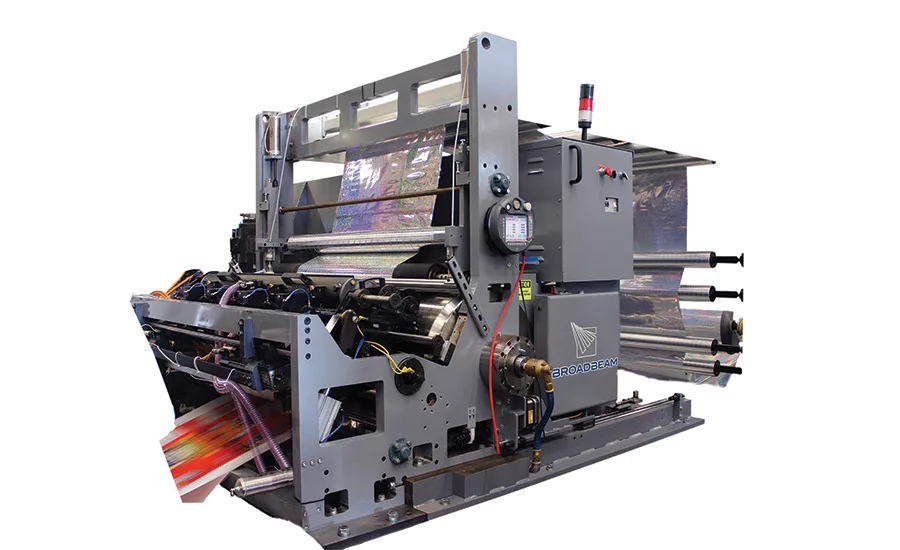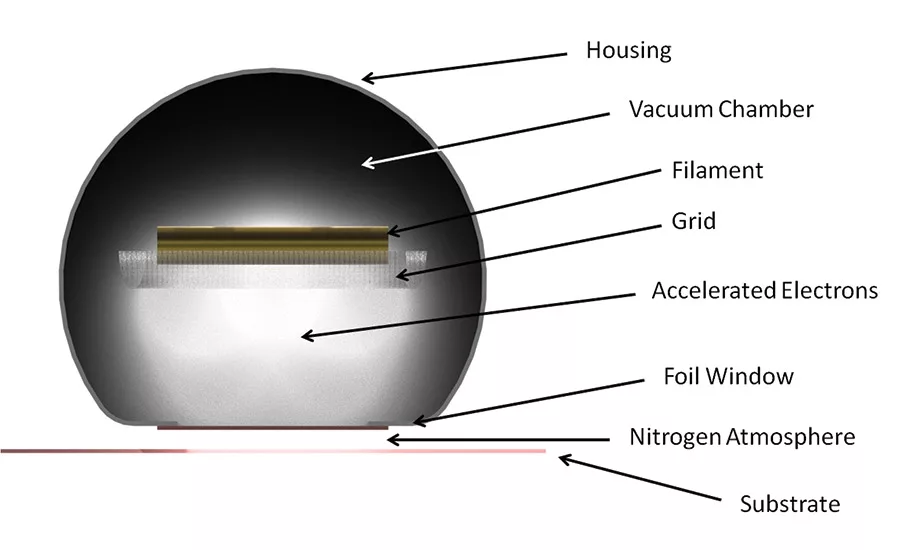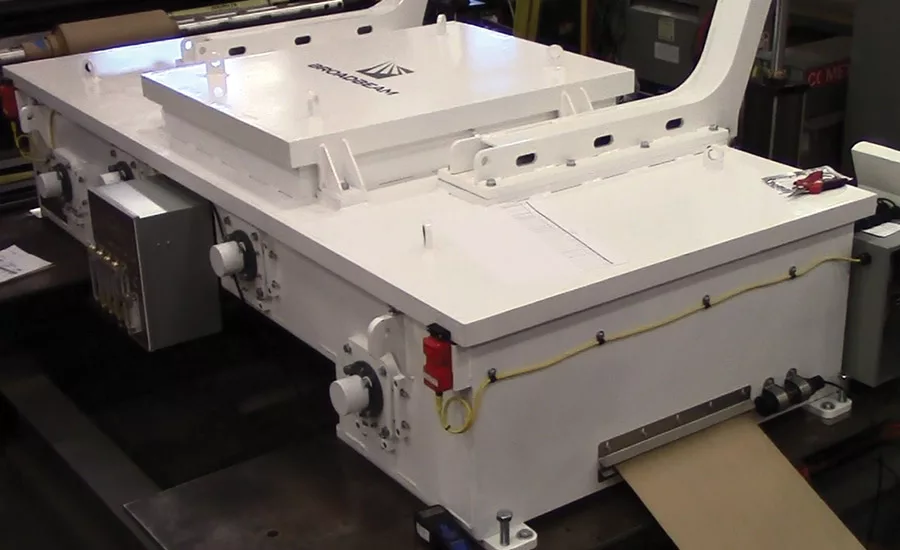A New Cure for Adhesives and Sealants
Ebeam technology continues to become more recognized as a safe and effective crosslinking and curing option.



Narrow web converters like label makers can benefit from ebeam technology’s food safety benefits.
Long regarded as a highly specialized option for curing and crosslinking adhesives, coatings and inks, ebeam technology continues to earn a reputation for being both powerful and cost-effective. Printers, converters and manufacturers of pressure-sensitive adhesives (PSAs) have documented numerous real-world advantages generated by ebeam, including improved product performance, superior product consistency, higher process throughput, and greater energy savings. In addition, recent breakthroughs in ebeam use for surface decoration have led to packaging with more visual “pop.”
Ebeam Basics
In an ebeam system, electrons are generated in a vacuum chamber using an electronically charged filament, usually tungsten (see Figure 1). These electrons are then accelerated through a thin, metallic foil window onto the moving web surface. These accelerated electrons ionize most organic materials, which leads to the formation of free radicals. This reaction initiates polymerization of liquid polymer monomers and oligomers. The end result is instantaneously “drying,” or curing, of an ink, paint, coating or adhesive, often with the added bonus of strengthening the impacted material (known as crosslinking).
Though far from being new (ebeam technology has existed for over 40 years), it continues to gain traction among adhesives manufacturers and package converters as an alternative to oven (thermal) drying and ultraviolet (UV) curing. Ebeam systems are much less expensive and require a much smaller footprint than building and operating an oven-drying system. In addition, ebeam machines generate very little heat when coming in contact with the substrate being cured, making them a superior choice over oven drying when curing heat-sensitive materials like thin films.
The Adhesive and Sealant Council promotes the use of fewer potentially dangerous volatile organic compounds (VOCs) in formulations to reduce emissions and odors that can contribute to things like respiratory issues and compromised air quality. To this end, adhesive, laminate and coating formulas are not created equal; “standard” coatings require heat from ovens to extract water or solvents from them and dry. Ebeam-friendly formulations, however, contain no solvents that need to be flashed off; as such, the technology produces virtually no VOCs, unlike oven-based thermal curing.
While ebeam systems are traditionally more expensive than comparable UV systems, they offer substantially more consistent output (since UV lamps weaken over time) and more efficient energy usage. Depending on the size and speed of a given converting operation, the payback period from switching from UV to ebeam can often be calculated in months. Similar to oven drying, minimally heat-generating ebeam systems are more desirable than high-heat-producing UV systems when curing heat-sensitive materials like thin films.
Ebeam curing is able to penetrate opaque materials (such as pigmented coatings) more effectively than UV, and does not require a photoinitiator in its curing process, which is important among food packagers in allaying concerns about migration. In addition, the crosslinking effects of ebeam generate the added value of producing tougher, more abrasion-resistant converted surfaces.
Small Is the New Big
Interest in ebeam technology has grown significantly in recent years, both because of the increased availability of EB-friendly adhesives, coatings, inks and other materials, and because of increased affordability. In the past, ebeam machines were large and could be very expensive. Customers requested that smaller, less expensive ebeam systems be developed to provide cheaper, easier and less cumbersome integration directly into existing and new process lines. Equipment providers have responded to these requests by introducing innovative new designs that leverage advances in technology and years of industrial ebeam system experience.
Ebeam for Package Decoration
Another interesting wrinkle in the evolution of ebeam applications in converting involves extending ebeam beyond its traditional curing and crosslinking capabilities. With the addition of a recently developed four-in-one converting line, package printers can now also harness an ebeam machine to create innovative package design enhancement capabilities. A four-in-one converting line offers four interchangeable package enhancement operation modes: coating, laminating, cold foil transfer, and cast and cure.
Instant curing of coatings and adhesion of laminates with ebeam results in package surfaces featuring high gloss and inherent durability, neither of which can be accomplished using other curing technologies. Increased package brightness and strength capabilities can provide additional visual excellence to products while simultaneously reducing package abrasion and breakage risks.
The cold foil transfer process begins with the application of an ebeam-curable adhesive to the substrate in registration with the desired printed graphics. The substrate is then paired with a metalized film over its surface and ebeam cured. The metal transfers to the cured adhesive areas, producing a metallic visual effect. Nearly any type of hot or cold stamping foil can be used in an ebeam cold foil process.
Cast and Cure™ is a decorative coating process that effects the “casting” of holographic images with the “curing” of the effected coating.* Similar to cold foil transfer, an ebeam-curable adhesive is applied to a substrate in registration with the desired printed graphics. The substrate is then mated with a film containing the desired holograph and ebeam cured. Ebeam passes through the film and “freezes” the image onto the target coated areas as it cures them. Cast and Cure provides a consistent high-quality finish, and can generate ultra-high gloss, matte and holographic images onto a variety of substrates. This environmentally friendly process helps make packages more recyclable by eliminating the laminated, metalized films used in traditional holographic processes. In addition, casting film can be reused multiple times, helping converters achieve substantial cost savings.
Ebeam package decorating systems are designed for use with web printed packaging materials, including flexible packaging, folding cartons, labels and multi-wall bags. These systems work effectively at high speeds, are compatible with wide web widths, and generate low substrate heating, which is important when using sensitive flexible packaging materials like thin films.
Conclusion
Though still far from being a household name, ebeam technology continues to grow more recognized as a safe and effective crosslinking and curing option. In most circumstances, it provides a more cost-effective, powerful, and safer alternative to thermal drying and UV light curing. While ebeam systems are most frequently associated with curing printing inks, adhesives and coatings for packaging applications, they are also used to crosslink plastic shrink films, cure coatings to metal, wood and composite building materials, cure digital inkjet, and for surface sterilization.
A key initial step companies can take in evaluating whether ebeam technology might be advantageous involves their better understanding of the available types of ebeam systems, and evaluating what they want to accomplish. As the quality, versatility and accessibility of ebeam-friendly adhesives, coatings, and inks continue to evolve, ebeam systems continue to prove themselves a viable alternative.
For more information, visit www.teampct.com.
Looking for a reprint of this article?
From high-res PDFs to custom plaques, order your copy today!





